 Check it out here.
Check it out here.The list is in chronological order so the earlier 50's models are first and the last Powerlite designed lumes from the 90's are in the end.
Sections:1: 1959 and prior Powerlite Fixtures
2: 1960s Powerlite fixtures
3: 1970s-1980s Powerlite Fixtures
4: 1990s Powerlite Fixtures
5: Other Powerlite Fixtures
6: Speculative Powerlite Fixtures
7: Version History and Credits
[PWR 1]
Section 1:
1959 and Prior Powerlite Fixtures
The earliest known Powerlite fixtures are of the gumball design which was introduced during the post war era. These lumes had no mounting provision for a internal ballast as so were mostly used with incandescent lamps. Later on during the rise of mercury some were converted to use mercury vapour lamps by replacing the incandescent lamp with a mercury lamps and wiring in a external ballast...easily identified by the "paint can" mounted near where the mounting arm meets the pole. Metal poles could also be outfitted with a transformer base to conceal the ballast for a cleaner appearance. Mercury lamps were more efficient than incandescent lamps but the blue-green colour of the commonly used clear lamps proved unpopular to some. At the time coated or colour corrected mercury lamps (which had better colour rendering) were still too expensive to be commonly used for streetlighting.
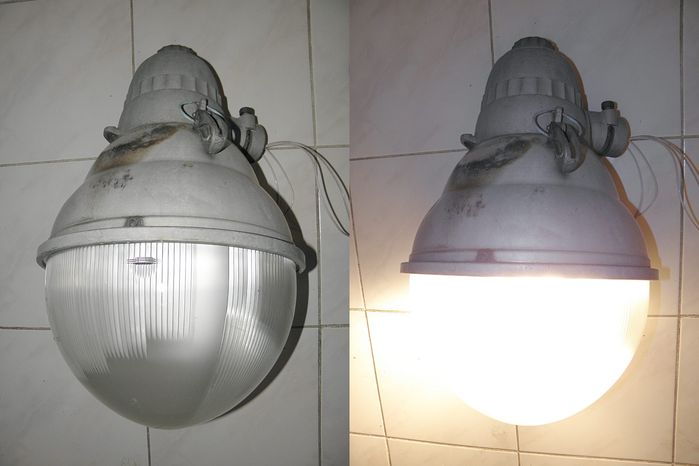 "Gumball"
"Gumball" Unknown model number gumball luminaire, designed for main roads, and early freeways.. The head conforms to NEMA specifications and uses a latch on Holophane refractor. The refractor latches on and off for relamping...I'm not sure if hinged refractor versions were available. Used incandescent lamps but could use mercury lamps when paired with a suitable remote ballast.
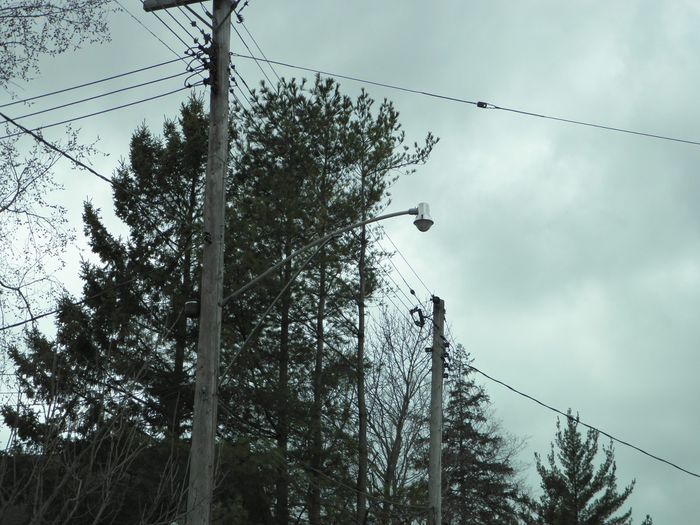 "Mini Gumball"
"Mini Gumball" Unknown model number mini gumball luminaire designed for residential streets. Used either incandescent or mercury lamps when paired with a remote ballast up to 100w. Interestingly they use a medium base instead of the common for streetlighting mogul base. Also as shown in
Niall's picture the refractor opens up for relamping in a very unique way. Note that the pictured example has a "paint can" external ballast installed so it could use mercury lamps.
[PWR 2]
Section 2:
1960s-1970s Powerlite fixturesAround the 1960s the hassle and labour costs from wiring an external ballast led to the introduction of fixtures with provision for mounting an internal ballast. A common style fixture like this was known as a cobrahead named for their cobralike appearance when on a mounting arm. Powerlite came out with their first generation of cobrahead roadway fixtures and their version of the popular area light the GE Powr/Bracket which was known as the "Private Eye".
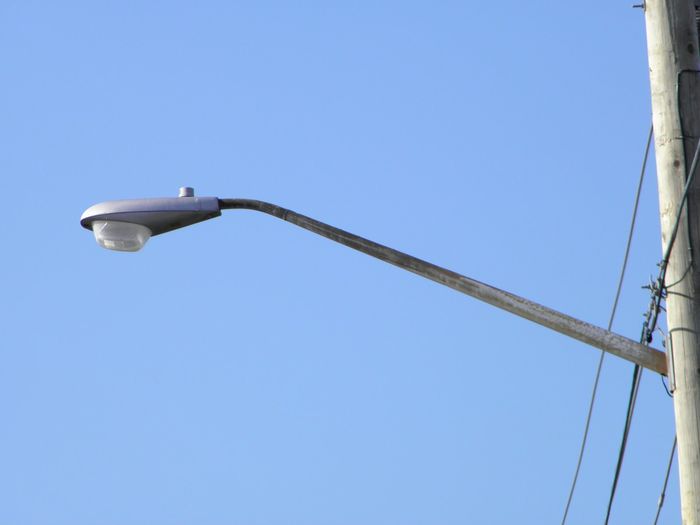 Powerlite B2217,
Powerlite B2217, a small sized cobrahead that was introduced around the 1960's or so, it used up to 250w mercury lamps. I know of a few that have been retrofitted to sodium in my area along with some mercury ones along the mid 60s sections of the Bloor-Danforth subway.
Parts to look for: small size, long slender body, streamlined door, and the squared refractor is also a unique characteristic to this lume.
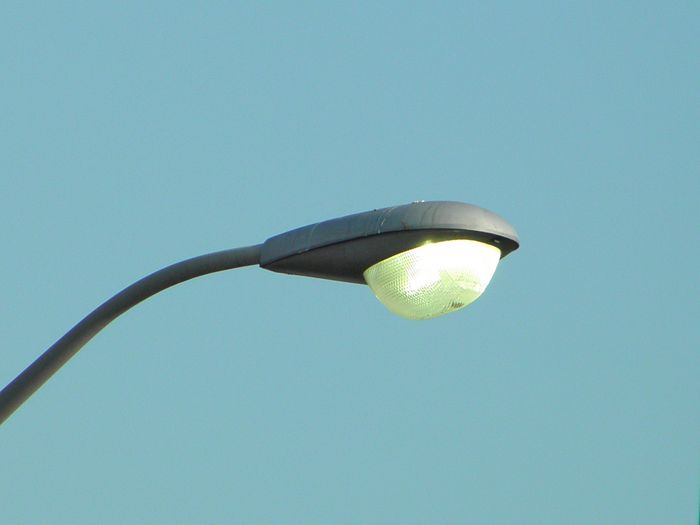 Powerlite B2215,
Powerlite B2215, a relatively large medium sized cobrahead that used up to 400w lamps? Was introduced sometime during the 1960s and I guess was originally fitted with mercury lamps but I've seen ones that are presumably retrofitted to HPS. Thanks to Dave for ID'ing this for me. They're not that commonly found nowadays, I only know of some in parking lots and some retrofitted ones in the Kitchener area.
Parts to look for: streamlined torpedo like body, pointed nose, diamond patterns on refractor, slightly chubbier than the other Powerlite cobras of this era.
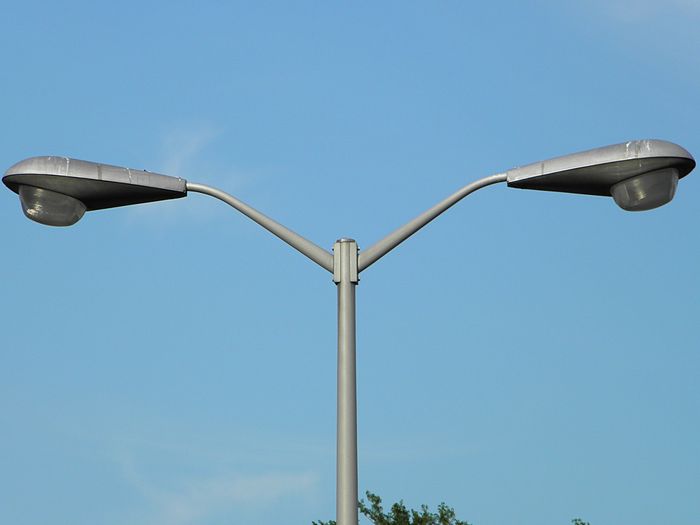 Powerlite B2213,
Powerlite B2213, a huge cobrahead that used up to 1kW lamps. This is the biggest Powerlite lume (it's around 4 foot long) and I'm guessing it was introduced sometime during the 1960s and was made at least through to the 1970s. It appears to use it's own unique refractor pattern. They used to be quite common along 1960s MTO freeways like the 401 prior to reconstruction with HPS highmasts but I'm not aware if they were ever used for streetlighting. They are still found in some older parking lots...particularly 60s era strip mall lots.
Parts to look for: large size of lume compared to others, large refractor, long streamlined body, and slightly blunt nose.
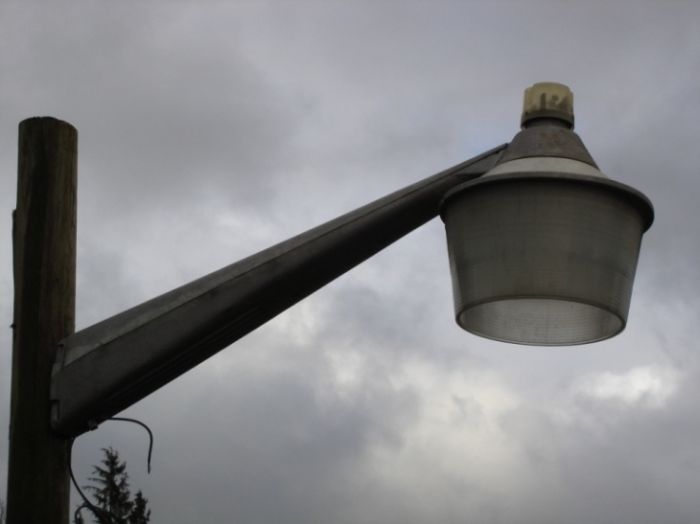 Powerlite "Private Eye",
Powerlite "Private Eye", a powrbracket style HID area luminaire that was introduced during the mid 1960s and redesigned some time after. It was used mainly as dusk to dawn security lighting in rural areas. (pic from Darren)

Unknown model fluorescent streetlight and very rare too. This particular one looks like it uses 6 foot HO/VHO lamps but I have also seen 4 foot versions in the wild. As far as I know they were rarely used for parking lots but they used to be used along some arterial roads and expressways in Toronto, especially ones built by the former Metro Toronto.
[PWR 3]
Section 3:
1970s-1980s Powerlite fixturesAround this time Powerlite Devices Limited was acquired by GTE Sylvania Canada and around the mid 1970s the fixtures had Sylvania co-branded with Powerlite and by the late 1970s the fixtures were branded only with Sylvania on the tag. Powerlite branding that was cast into the fixture still remained. The first generation of cobraheads was replaced with the more compact second generation and new fixture designs such as the TwistPak, SignLite, Modular Luminaire, and SpherePak was also introduced. Also this is when Powerlite first added a option to outfit fixtures for sodium lamps instead of mercury lamps. Sodium lamps were more energy efficient than mercury at the expense of colour rendering. As such they increased in popularity after the two oil and energy crises increased energy costs.
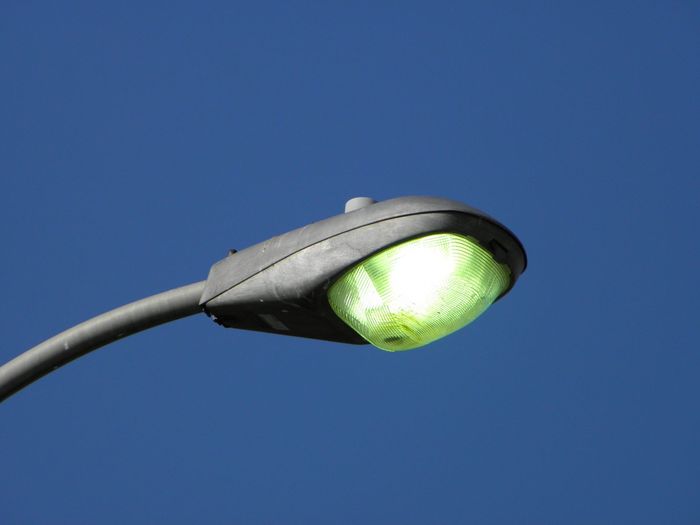 Powerlite B2227,
Powerlite B2227, (or the
Sylvania R37) a small sized cobrahead that I THINK was introduced during the 1970's and used up to 250w lamps. They used either mercury vapour or sodium lamps depending on what the customer ordered. It later became the Sylvania R37 when Powerlite Devices was bought out by GTE Sylvania.
Parts to look for: small "GE-like" appearance, centre mounted PC, Powerlite logo on bottom door, and sprung clip door keeper.
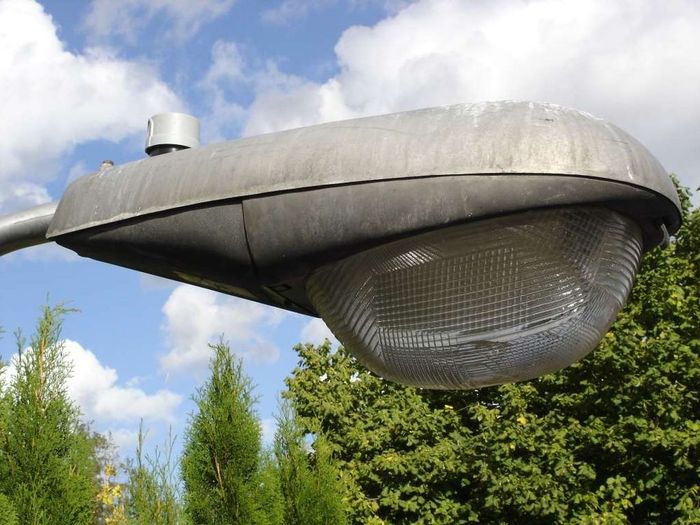 Powerlite B2255,
Powerlite B2255, a medium-large sized twin door cobrahead that was introduced in the early 1970's (it was patented in 1971) and used up to 400w lamps but a 1kW version that accepted BT56 lamps was made (see note below). It used either mercury vapour, metal halide or sodium lamps. It has a similar appearance to a GE M400-A2 or a M-400 split door cobrahead but the refractor on the Powerlite is larger than GEs and the B2255 is usually unpainted, while the GEs were painted light gray. The ballast was either mounted in the top housing of the luminaire or mounted on the rear removable ballast door with a power disconnect connector. The luminaire itself was also available in a
full cut off / flat glass lens instead of the traditional dropped lens. (Pic from Darren)
Parts to look for: large and chubby refractor, PC mounted near back of lume, Powerlite logo on rear ballast door, and no latch for rear door...only a screw keeps it shut.
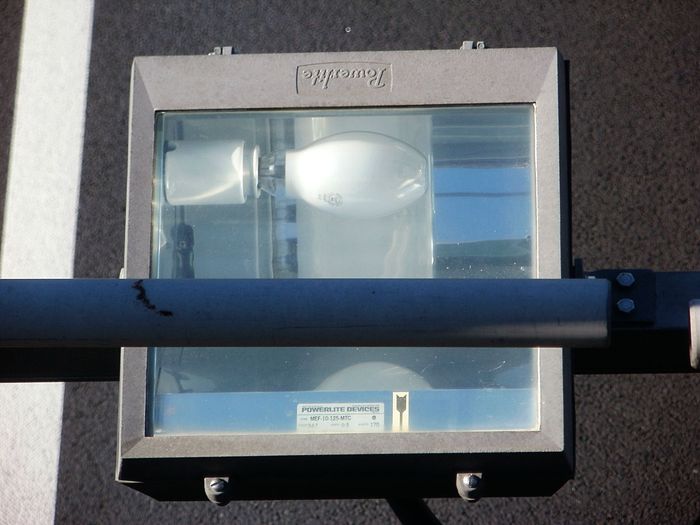 Powerlite MEF-10 "SignLite",
Powerlite MEF-10 "SignLite", a smallish floodlight that was introduced in the mid 1970s (patented 1974) and was intended for overhead freeway sign illumination as well as billboard/sign lighting, known to have used either 125w mercury or 70w sodium lamps but most likely more types and/or wattages of lamps were used. This particular one has a Cat# of MEF-10-125-MTC.
Parts to look for: small boxy shape, bare finish, two screw latches on side facing road, Powerlite logo if viewed from the top, off centre lamp.
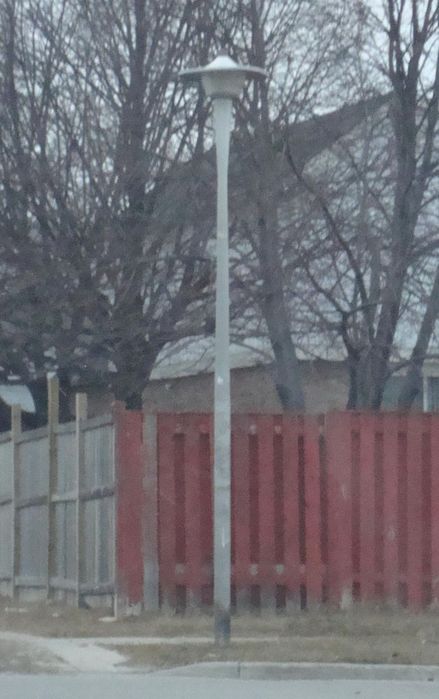 Powerlite "Twistpak"
Powerlite "Twistpak", a post top luminaire that used up to 250w lamps. The pictured example is integrated into the pole but the regular posttop version is more commonly seen. The separate model continues production as the American Electric
Twistpak, one of the few Powerlite designed lumes still made. (pic from Niall)
Parts to look for: spaceship like appearance, long and tapered ballast compartment, generally bare finish, centre mounted PC.
Notes: The B2255 might have been made through part of 1990s and it's very possible that the other designs were at least made through the early 1990s.
The B2255 was also made as a version with a modified socket mount and reflector that supported up to BT56 1kW lamps, it is not sure at the moment if this configuration had the B2255 model# or the B2228 model#
There where two different ballast mounting configurations for the B2255, it could have been door mounted that disconnected when the rear door was opened like a GE Powr/Door (although GE Powr/Doors didn't auto disconnect). Or it could have been mounted in the top housing without the quick disconnect like a GE split door cobra. As far as we know there are NO external differences to differentiate between the two unlike the GEs.
The Twistpak was made all the way up to the acquisition of Powerlite in 1998 and continues production as the American Electric Twistpak.
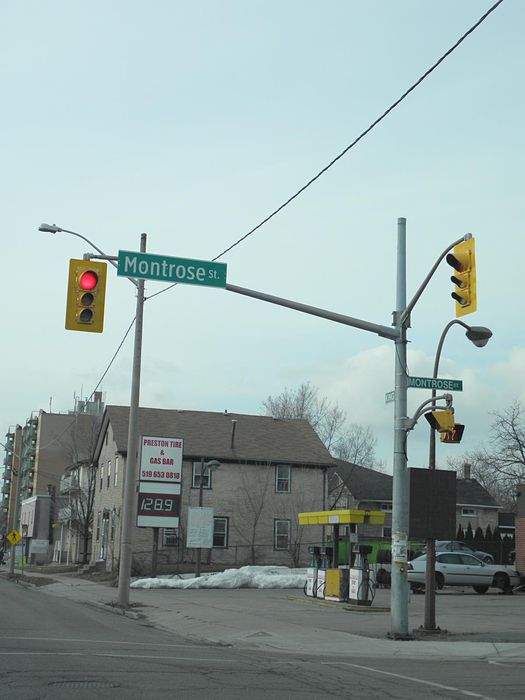 Modular Luminaire
Modular Luminaire a track mounted set of fixtures that used ~175w mercury lamps, one of the applications of this was lighting up gas pump islands.
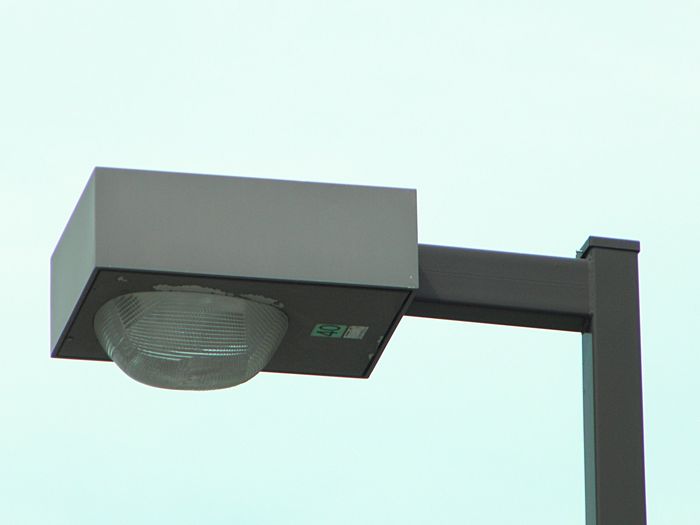 Sylvania Powerlite "shoebox" fixture,
Sylvania Powerlite "shoebox" fixture, a medium sized "shoebox" fixture that used a B2255 drop refractor and seen with up to 400w lamps. I'm not sure what the model # of this is though.
[PWR 4]
Section 4:
1990s-2000 Powerlite fixturesGTE Sylvania owned Powerlite until July-August of 1993 shortly after the accquistion of GTE Sylvania by Osram who later renamed the lamp division Osram Sylvania. The fixture division was sold off. Powerlite was sold off to a company known as the Kaufel Group. The 90s saw the introduction of two small sized cobraheads the R47 and later the R7 both of which were largely used with sodium lamps instead of the traditional mercury vapour lamps. In fact around this time many cities in Ontario were changing out the old mercury fixtures to sodium and one common fixture used to replace the old mercury lights was the R47.
 Sylvania-Powerlite R47
Sylvania-Powerlite R47, a small sized cobrahead that was introduced in 1992 (date from the instruction sheet) and used up to 400w lamps. This luminaire was also available in a full cut off / flat glass lens configuration instead of the traditional dropped lens. Not sure when this was made until, I've seen them go up as late as 2002-2003.
Parts to look for: angular door, PC mounted near rear of lume, sprung clip door keeper.
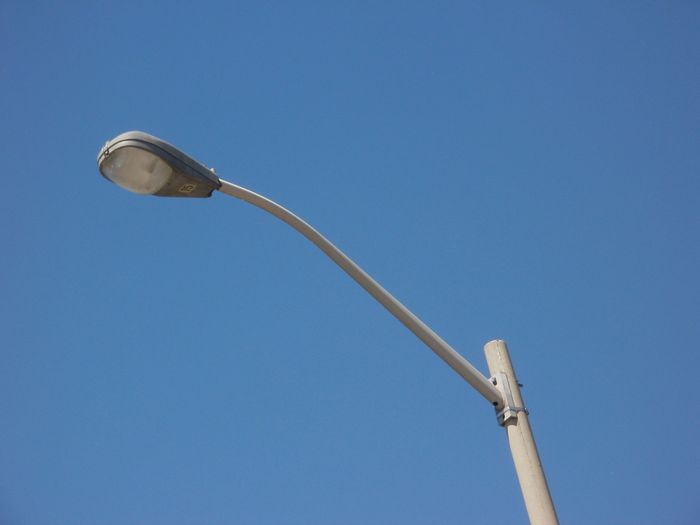 Sylvania-Powerlite R7
Sylvania-Powerlite R7, a small sized cobrahead that I think was introduced during the early to mid 1990s and used up to
250w 400w lamps. The Powerlite product page linked above also calls the R7 a "RoadKat". This lume features a updated slipfitter design as well as a modernized appearance.
Parts to look for: more streamlined door, and mounting bosses for slipfitter screws on the top.
Description from Powerlite website:
"Our new R7 RoadKat is one of our latest highly efficient and low profile luminaires to come out of our new plant. Its optical assembly makes it the ideal choice for roadways and parking lots which require different light levels in a rugged luminaire-available up to 400 W in HIOH [sic] Pressure Sodium, Metal Halide or Mercury vapour."
In 1998 The parent company of Powerlite, the Kaufel Group was accquired by Thomas and Betts and most of the Powerlite models here were eventually phased out.
[PWR 5]
Section 5:
Other Powerlite fixtures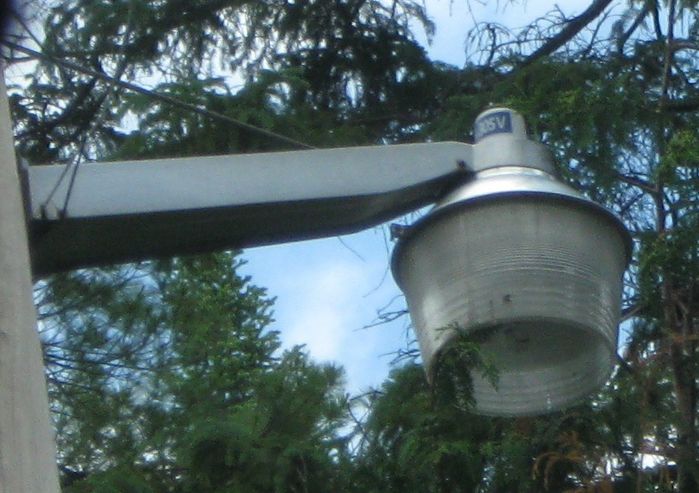 Powerlite "Private Eye"
Powerlite "Private Eye", a Powr-Bracket style HID area luminaire that was introduced during the mid 1960s and redesigned later. It was used mainly as dusk to dawn security lighting in rural areas. (pic from Niall)
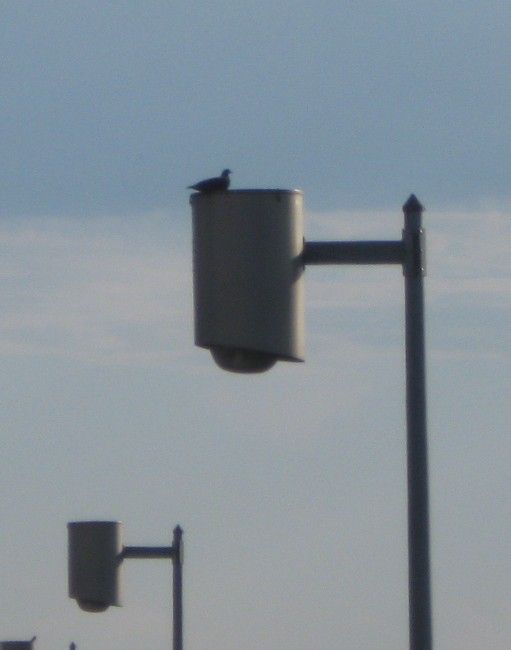
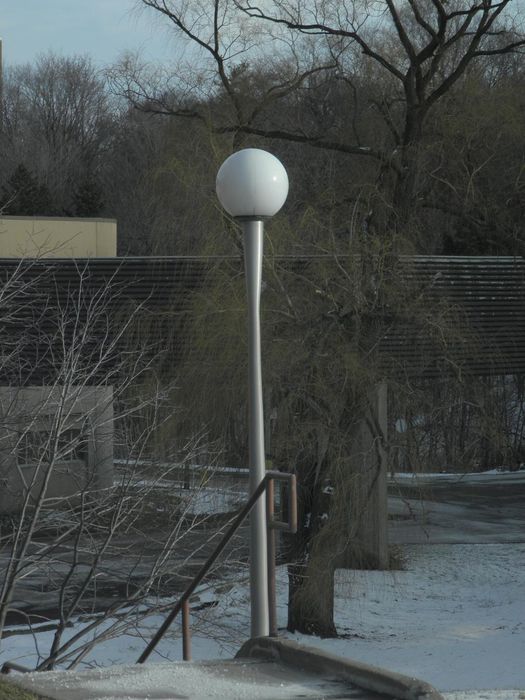
Unknown Powerlite post top luminaire, this could possibly be a Powerlite "Spherepak" luminaire?
Powerlite "Wallpak-2" A wall mounted outdoor fixture, not much is known since I only have
this about it.
Apparently there was also a Powerlite B2228 "TwinDor" large sized cobrahead that used up to 1000w lamps but we do not know at the moment if the B2228 had a distinct body or was just a 1kW version of the B2255.
There was also a B2214 "New Little Giant" which was a small fixture that used up to 300w med. base incandescents or 125w mercs. I can't find any more info about both of these other than the name and model though.
[PWR 6]
Section 6:
Speculative Powerlite FixturesFinally, here's a list of some unidentified Powerlite luminaires that I have guessed their model # and name based on how they look and from the above documents:
If you have any more information on these or any other Powerlite luminaire(s), please feel free to reply below or to PM me. I'd love to find out more about Powerlite lumes and the company.
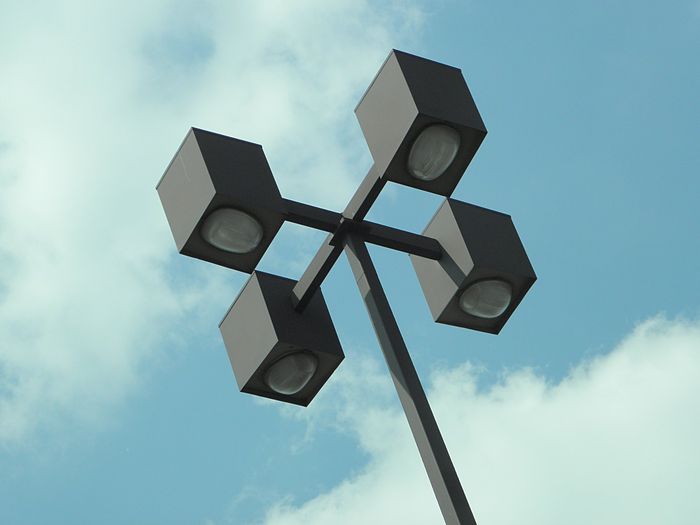
[PWR 7]
Section 7:
Version History and CreditsUpdates:12-28-10
First version.
12-30-10
Added Private Eye Pic and description.
01-02-11
Added additional Private Eye pic, minor spelling/grammar corrections.
01-26-11
I found some more pages on Powerlite as well as a archived copy of the Powerlite webpage, so I rewrote the intro and updated the R7 entry.
03-17-11
Long time since my last update, found out the boxy lume is actually a Skyline Skylight lume, also made some minor edits.
03-21-11
Thanks to Dave for ID'ing the B2215 for me (the bid unknown 60s era Powerlite). Also rewrote the B2215's entry.
04-29-11
Added links to pictures and made some minor edits.
07-03-11
Added B2213 entry.
07-21-11
Fixed up some stuff and split the guide from the info links to make it easier to read.
Added a couple entries too.
08-09-11
Split guide up into sections for easier navigation.
08-11-11
Added entry for the shoebox fixture.
08-24-11
Updated Powerlite B2255 entry in light of Niall's recent pics.
10-22-11
Added distinguishing features for the cobras.
11-12-11
Replaced some of the pics with better ones.
01-22-12
Added entry for the fluorescent streetlight and updated pic for the SpherePak
02-23-12
Added entry for Powerlite Gumball
03-13-12
Added entry for mini gumball, and Modular Luminaire. Also added short intros to each section.
07-14-12
Updated picture for the B2213
Thanks to Darren (litelover) and Niall (Gailgrove) for letting me use their pics as part of this guide as well as Darren, Niall, Dave, and Vince for providing me with additional information.